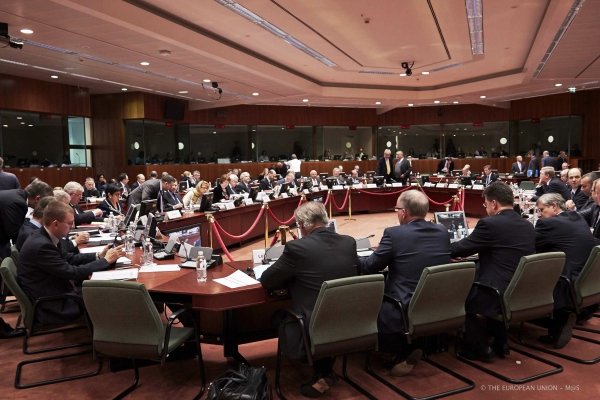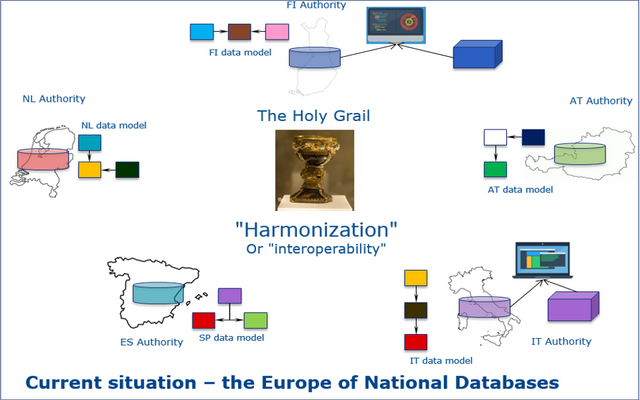Incentive-based regulation - Blockchain opens up a new era of European integration
"A la contrainte, je veux privilégier l'incitation"
Emmanuel Macron, French President
Emmanuel Macron, French President
European dialectics
Advancing the European project often involves "harmonizing" 27 (or more) different ways to doing essentially the same thing.
Getting so many countries to adopt a common way of tackling issues which were previously seen as national has many advantages. Among these, it opens the possibility of creating effective tools which can then be used by everybody (rather than having every country invest in its own tool).
Yet at the same time it is a challenge, as national pride and vested interests often get in the way. For every given issue, one typically sees more than one country jockeying to have its own way of solving it be adopted as "the common European way", so that national politicians can claim success and national tool producers can start selling the same tool to all the other countries.

The Council of the EU (where National Governments send their Ministers) is where decisions are being taken
Like in practically all human endeavors, centralized decision-making, uniformity, standardization are the most effective and efficient way to progress in political undertakings. As people in the "cryptoverse" are keenly aware, centralization and uniformity do have some major drawbacks nonetheless:

The Council of the EU (where National Governments send their Ministers) is where decisions are being taken
Like in practically all human endeavors, centralized decision-making, uniformity, standardization are the most effective and efficient way to progress in political undertakings. As people in the "cryptoverse" are keenly aware, centralization and uniformity do have some major drawbacks nonetheless:
- uniformisation stifles creativity, but moreover
- centralization greatly increases the risk of abuse (by those who are the recipients of centralized power)
Corollary
Joint progress can only be achieved by maintaining a dynamic equilibrium between centralized, uniform, standardized decision making and a certain degree of dissent, diversity and nonconformism.
European Regulations
Policies are notoriously difficult to get right. Depending on the "national psyche", some policies work well in some countries but not in others, the clearest example being the general level of taxation (France and the Nordic countries can cope with a far higher level than most other countries).
When it comes to regulations though, the benefit of a uniform approach usually far outweighs the risks and most people agree with this. Yet that doesn't make the "European nut" any easier to crack.
Take mandatory reporting: it would be hard to argue in favor of enforcing 27 different reporting formats, the benefit of having one harmonized format is obvious. Hence one of the main work area of the European Commission is to harmonize reporting across the Continent.
Most of the time, the work doesn't start from scratch but instead from a situation where each country has its own reporting format, which the target economic actors fill in and submit to a "National Database". The result is a Europe of National Databases containing information about similar things in autonomous data structures, designed with no regard to what "the neighbors" were doing.

Why Blockchain can boost European regulatory harmonization
The typical modus operandi of the Commission when it tackles pan-European regulatory harmonization is summarized in the picture below: an "agency" is set up and asked with merging the 27 different reporting formats into a comprehensive one (while minding semantics) and, often, bringing the data "under one roof" in order to facilitate reuse and reduce administrative burden for the economic actors.
Unfortunately, the result of this approach falls short of expectations more often than we would like. The reason for this is ... human nature. Always and everywhere, regulators are centers of power, and places where power accumulates attract actors wanting to leverage it for generating money.
While every country may theoretically agree that regulatory harmonization is desirable, the embarrassing truth is that, in each and every country, powerful interests spontaneously assemble around the regulatory processes and institutions and devise ways of harnessing those processes for commercial profit. The resulting attitude of the Member States is similar to that of Saint Augustine praying "Lord, make me chaste, but not yet!"

How to get your children to eat their vegetables
In the end, what the Commission needs to have the Member States do is not unlike what parents are confronted with when rearing children. How do you get someone from your family to do something which is good for them and good for the whole family?
- You can appeal to their own "family spirit" and a shared understanding of good and bad
- You can try to mandate and threaten some kind of punishment in case they don't comply
- You can entice them with something they like
- Any combination of the above
"Vegetables are good for you" - the cargo ship "Reporting Formalities Directive" example
The Reporting Formalities Directive (RFD) was issued in 2007 as a tool to establish a simplified reporting environment for ships – aimed at reducing administrative burden for shipping by coordinated and harmonized reporting.
The specific objectives of EU action back then (a Directive recommending a non-binding common format):
- Harmonize reporting procedures, interfaces and data formats
- Provide a single entry point
- Facilitate data sharing/reuse for the application of the "reporting only once" principle
Ten years later, the 2017 REFIT evaluation concluded that "the RFD is inadequately effective and efficient".
Polled, 55% of shipping operators found that the "administrative burden has increased rather than decreased"!
"The inadequacy of voluntary harmonisation measures has been shown in the past. The existing non-binding guidelines [...] have not improved the situation"
Polled, 55% of shipping operators found that the "administrative burden has increased rather than decreased"!
"The inadequacy of voluntary harmonisation measures has been shown in the past. The existing non-binding guidelines [...] have not improved the situation"
A few selected quotes from the "Impact Analysis" document:
"Recipients of cargo or ship information are reluctant to share data since the legal framework – as regards aspects of data control, confidentiality, liability and access rights – is perceived as unclear."
"Recipients of cargo or ship information are reluctant to share data since the legal framework – as regards aspects of data control, confidentiality, liability and access rights – is perceived as unclear."
"Operational National Single [Reporting] Windows are still under implementation in 8 of the 23 maritime MS. Where NSW are implemented, there are not always national procedures, national technical standards, or an actual single entry point for reporting.
Ultimately, Member States have not had sufficiently hard incentives to establish their National Single Windows in a harmonized way"
"No vegetables, no dessert!" - the European Electronic Access Point example
The "Transparency Directive" mandated data sharing among national authorities called "Officially Appointed Mechanisms" (OAMs) and the subsequent "Commission Delegated Regulation 2016/1437" went into much detail specifying how this should be implemented. This is European regulatory harmonization at its finest, "Thodore Roosevelt style" ("Speak softly and carry a big stick")
However, the envisaged implementation ran into robust opposition as it appeared to threaten the business models of the national OAMs. Click on the short video below to see the animation
Two years after the EEAP was supposed to be live, the implementation project has not even started ...
Enter the Blockchain: "If you eat your vegetables, you get double cake!"
The "Impact Analysis" of the Reporting Formalities Directive quoted above estimates (Annex 6) that the reporting burden costs shipping operators about 176 million euro per year. One can assume that truly reducing that burden has a monetary value for shipping companies and that they would be willing to share some of the gains from increased efficiency with the Port Authorities. There should be possible to devise a win-win mechanism, especially with the availability of an European agency acting as "trusted third party", .
Blockchain systems make implementing "economic mechanisms" (a.k.a. incentive-schemes) cheap, fast and secure. In the short animation below, we depict a simple one that could be implemented using the steem-based "EU blockchain" (the name of the ports used in the animation are just examples)
Note that the "EBE" coin is fully backed by euros and thus closer to the recently launched "JPM coin" of JP Morgan Chase than a "cryptocurrency". That doesn't make it any less useful for the problem at hand.
As for the EEAP problem, as you might know if you followed my blog, it led to the European Financial Transparency Gateway (EFTG) pilot, for which the following economic mechanism has been proposed
The OAMs represented in the animation are examples only. The blockchain used is a slightly-modified clone of steem dubbed "EU blockchain". It enabled the pilot project to be delivered in record time and on a very frugal budget.
Conclusion
It is the first time in history when implementing economic mechanisms that incentivize economic and political actors to do the right thing becomes practical.Incentive-based regulatory harmonization is a radically different approach to complement existing ones.
Yes, "incentive-based regulation" is theoretically possible even without blockchain. But "possible" does not, and until today never rhymed with "practical" nor "economical". Custom-designed and built IT systems tend to be costly, take years to implement and are often plagued by serious bugs, as was recently illustrated by the WiFi4EU policy for which the Commission preferred "the devil it knew" of classical IT rather than the "new ch(a)i(n)ld on the block".

If you know what witnesses are and agree that people commited to keeping this blockchain ticking play an important role ...

No comments:
Post a Comment